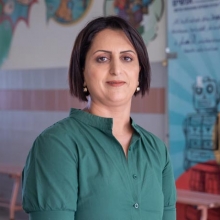Mario Livio
A curious mind
Alumni

Last year, the Hubble Space Telescope turned 25: Since its launch from Cape Canaveral, Florida, it has been circling Earth for a quarter century, capturing important objects from dust clouds to distant galaxies, and in the process, widely acclaimed beautiful images (such as the image on these pages of spiral galaxy M106).
Prof. Mario Livio’s tenure as a theoretical astrophysicist at the Space Telescope Science Institute in Baltimore, Maryland—which operates Hubble - is nearly as long: 24 years. But after retiring last year, he says he’s working harder than ever doing what he loves most: researching and writing.
Prof. Livio, who received his master’s degree in theoretical particle physics at the Weizmann Institute in 1972, may be just as well known for his bestselling popular science books and his public talks as for his research on supernova explosions and how they can be used to determine the rate of expansion of the universe. He has generated hundreds of journal articles on black holes, dark energy, and the formation of planetary systems; and at the same time, his books and talks speak to the masses, explaining in simpler but highly convincing language why science matters to all of us.
As one indicator of his instinct to bridge the audience of scientists and the general public, his article in Nature last year summarized Hubble’s success both as a scientific achievement, attaining reams of unprecedented scientific information and attracting more scientists to the field, and also hailed it as a public relations vehicle for science in society. Thanks to Hubble and other satellites, he writes, “For the first time in human history, an answer to the question, ‘Are we alone?’ is within reach.”
Born in Romania, Prof. Livio moved to Israel at age five. He served as a paramedic in the Six Day War and the Yom Kippur War. He received his bachelor’s degree from the Hebrew University, and at the Weizmann Institute, he says two instructors made a deep impact on him: Prof. Harry Lipkin, who died last year, and Prof. Haim Harari. He went on to get a PhD in astrophysics from Tel Aviv University and was a professor at the Technion for a decade before moving to Baltimore in 1991 to work for Hubble.
Having been a student or faculty member on four Israeli campuses—and a frequent visiting scientist at some of them, including at the Weizmann Institute, where he spent two weeks this winter—he has a reliable grasp of the quality of astrophysics research in Israel.
“It used to be that astrophysics research in Israel was limited because we only have a small telescope in the Negev, and we didn’t have access to the big telescopes in the world,” which can cost around $10 billion (like Hubble), he says. “But now that scientists obtain time on the big telescopes, that limiting factor has disappeared, and Israel now has internationally leading astrophysics groups comprised of many ‘observers’. It used to be that most Israeli astrophysicists were theorists like myself and not observers for this reason. But Weizmann in particular has been phenomenal in recently hiring extremely good people, quite a few of them observers.”
Communicating science
In the 1980s, when the Technion began filming some classes for students who missed them while on IDF reserve duty, two of Prof. Livio’s courses were among them. He received positive feedback from students - and thanks to YouTube, he continues to—which made him think about communicating science in other ways to the broader public. He has written pieces on several blogs. He published his first book, The Accelerating Universe, in 2000. It didn’t become a bestseller, but he found a labor of love in writing, and he went on to pen The Golden Ratio (2003), which was a bestseller in the U.S. and Italy. Its positive acclaim even surprised its author; after all, the topic is mathematics, and specifically the number phi. He went on to write two more books about math, The Equation that Couldn’t be Solved (2005), and Is God a Mathematician? (2009).

Prof. Mario Livio
Why math? “I am a theoretical physicist—math is what I eat for breakfast,” he explains. “Some of the greatest compliments I’ve ever received have been when a person comes up to me and says: ‘The reason I did a PhD in math is because I read one of your books’. To me, this is what makes it all worthwhile.”
He goes on, “After I wrote The Accelerating Universe, which was about astrophysics, I decided not to write books about my personal research area. Instead, I wanted to use the time to explore different areas of science. I want to enhance appreciation for how critical science is to our lives. In today’s world, you can’t say you are not interested in science. Science is all around you and is essential in everything you do.”
For his latest book, Brilliant Blunders (2013), he took a leap outside math into biology, chemistry (and physics). As the subheading suggests (From Darwin to Einstein—Colossal Mistakes by Great Scientists that Changed our Understanding of Life and the Universe), the book explores the major discoveries and mistakes made by some of the household-name scientists of the modern era, emphasizing the importance of taking risks in one’s work, and also the critical value of ongoing research to examine and refine existing paradigms.
All of his books (excluding the first) have been translated into Hebrew and were bestsellers in Israel as well.
When he’s not researching the skies above or penning a new manuscript, Prof. Livio probably has his nose buried in an art book. He’s a self-proclaimed art fanatic who owns thousands of books on the subject. He jokes, “As a scientist, I could never afford to buy art so I bought the next best thing - books on art.” He says he sees a similarity between scientists and artists: “They are both looking at the universe around them and trying to give an account of it. Scientists try to explain the universe and make predictions about it. Artists try to describe it terms of their emotional response. So I think they are two complementary things - science and art - though they do not directly influence one another.”
Prof. Livio is already hard at work on his next book: on curiosity. “I’m an extraordinarily curious person, so I want to understand curiosity,” he says. The impetus for doing basic research, he adds, is grounded in that instinct. “You never know what basic research is good for when it’s being done, except satisfying your curiosity. However, often a decade or a century later, it shows to have great value. And there is no stopping us [scientists and others] in those terms. You can’t say, ‘Let’s not be curious’. It’s a natural human drive.”








